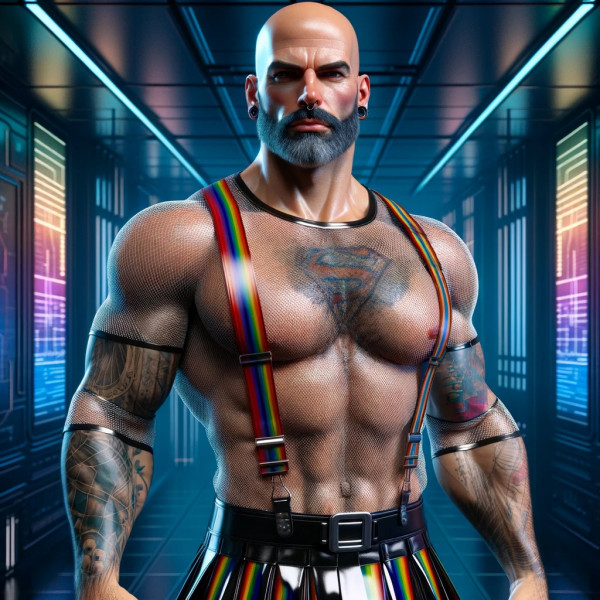Fashion and Pride Month:
A Statement of Diversity and Self-Confidence
Pride Month, celebrated every June, is not only a time for festivities and visibility for the LGBTQ+ community but also a showcase for creative and expressive fashion. Fashion plays a central role in Pride celebrations, expressing individuality, diversity, and the history of the community.
Symbolism and Colors
The rainbow flag, designed by Gilbert Baker in 1978, is perhaps the most recognizable symbol of Pride Month. Each of its six colors represents a different aspect of life and the community: red for life, orange for healing, yellow for sunlight, green for nature, blue for harmony, and purple for spirit. These colors are ubiquitous in fashion, appearing in clothing, accessories, and makeup. They serve as a proud sign of identification and support for the LGBTQ+ community.
Creative Expression
Fashion during Pride Month is colorful, bold, and often extravagant. Parades and events become stages where people can freely express their identity and creativity. From tailored outfits to eye-catching costumes, there are no limits. Fashion statements range from chic, rainbow-colored suits to artistic drag costumes, showcasing not only the diversity of the community but also their resilience and pride.
Support from Fashion Houses
Many major fashion brands and designers use Pride Month to show their support for the LGBTQ+ community. They launch special Pride collections, with proceeds often going to nonprofit organizations that advocate for LGBTQ+ rights. These collections are typically characterized by vibrant colors, inspiring messages, and symbolic designs. Fashion houses like Calvin Klein, Nike, and Levi's have presented impressive Pride collections in recent years, raising both awareness and financial support for the community.
Historical and Cultural Significance
Fashion during Pride Month also reflects the historical struggles and achievements of the LGBTQ+ movement. From the bold outfits of the Stonewall Riots activists to the glamorous looks of today's drag queens, fashion mirrors the evolution and cultural diversity of the community. Clothing thus becomes a medium of remembrance and resistance, keeping the history of the movement alive.
Conclusion
Fashion during Pride Month is more than just style—it is a powerful statement of self-acceptance, solidarity, and celebration of diversity. It reminds us of how far the LGBTQ+ movement has come and how important it is to continue fighting for equality and acceptance. By wearing and celebrating these fashion statements, we not only support the community but also promote a world where everyone can be free to be themselves.
Avoiding the Appearance of “Pinkwashing”
1. Long-term and Sustainable Support
Instead of engaging only during Pride Month, companies should implement year-round measures to support the LGBTQ+ community. This could include continuous donations to LGBTQ+ organizations, promoting LGBTQ+-friendly workplaces, and implementing inclusive company policies. For instance, they could introduce gender-neutral bathrooms and ensure that their job postings and internal policies consider diverse gender identities and sexual orientations [oai_citation:1,Pride 2021: How Can Brands Steer Clear of Pink-Washing? | Commetric](https://commetric.com/2021/06/25/pride-2021-how-can-brands-steer-clear-of-pink-washing/) [oai_citation:2,Pride Month and corporations: Genuine support or simply business?](https://stanforddaily.com/2019/07/26/pride-month-and-corporations-genuine-support-or-advertising/).
2. Authentic and Internal Integration
A company should ensure it also practices LGBTQ+-friendly policies internally. This includes training employees on LGBTQ+ issues, creating LGBTQ+ employee networks, and fostering an inclusive corporate culture where all employees feel comfortable and authentic. Involving LGBTQ+ employees in planning and executing Pride initiatives can enhance the authenticity of the efforts [oai_citation:3,The Impact Of Corporate Pride - CITI I/O](https://citi.io/2023/06/23/the-impact-of-corporate-pride/) [oai_citation:4,Pride 2021: How Can Brands Steer Clear of Pink-Washing? | Commetric](https://commetric.com/2021/06/25/pride-2021-how-can-brands-steer-clear-of-pink-washing/).
3. Genuine Partnerships and Community Investments
Instead of conducting superficial marketing campaigns, companies should form genuine partnerships with LGBTQ+ organizations and communities. This can be done by supporting educational programs, funding projects that promote LGBTQ+ rights, and sponsoring LGBTQ+ events and initiatives. Deeper collaboration with local LGBTQ+ groups can help understand and address their needs more effectively. An example could be partnering with nonprofit organizations that advocate for the rights of LGBTQ+ youth and supporting long-term projects [oai_citation:5,Wrapped in rainbows: Should big business be involved in Pride Month? | Euronews](https://www.euronews.com/culture/2022/06/30/wrapped-in-rainbows-should-big-business-be-involved-in-pride-month) [oai_citation:6,Pride Month and corporations: Genuine support or simply business?](https://stanforddaily.com/2019/07/26/pride-month-and-corporations-genuine-support-or-advertising/).
Collaboration Alternative: Partnership with the Human Rights Campaign (HRC)
A sincere collaboration alternative that appears genuine is a partnership with the Human Rights Campaign (HRC). The HRC is one of the largest organizations advocating for LGBTQ+ equality. Companies could show their commitment by making long-term donations, jointly conducting awareness campaigns, and participating in HRC events. This type of collaboration can build trust and respect within the LGBTQ+ community and bring about long-term positive changes.








